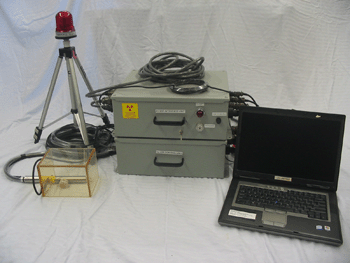 |
 |
 |
|
Borehole X-Ray Fluorescence Spectrometer (XRFS): User's Manual, Software Description, and Performance Report built by APL-UW under a NASA contract from the Langley Research Center APL–UW Technical Report 0703, December 2007 (  9 MB) 9 MB) |
|
 |
1NASA Langley Research Center, Hampton, VA 2Applied Physics Laboratory, University of Washington, Seattle |
 |
Contents User's Manual Overview Quick Start Guide Borehole XRFS Software Installation Instrument Design Hardware Description XRF Interface Unit XRF Control Unit Software Description X-Ray Tube Control (XTC) Detector Data Acquisition (DET) Save and Load Parameters (PAR) Save and Load Spectrum (SSF) Spectrum Processing (SP) Spectrum Display (SD) Instrument Performance Report Materials and Methods Test Plan Summary Results Conclusions Appendices (  PDF files) PDF files)
Acknowledgments This project was funded by NASA Headquarters as part of the Mars Technology Program, Subsurface Access Task, administered by the Jet Propulsion Laboratory. We are indebted to the program managers, Suparna Mukherjee and Chester Chu, for their guidance. The XRF spectrometer design and construction were performed by the Ocean Engineering Department of the Applied Physics Laboratory: Russ Light, Vern Miller, Pete Sabin, Fran Olson, Tim Wen, and Dan Stearns. The performance reported here is due to their efforts. The University of Washington effort was funded under NASA contract NNL05AA49C. |
 |
 when energized. Abstract The X-ray fluorescence spectrometer (XRFS) is designed to be deployed down a pre-drilled hole for exploration and elemental analysis of subsurface planetary regolith (Figure 1 and Figure 10). The spectrometer excites atoms in the regolith and causes them to emit their characteristic X-rays. These characteristic X-rays produce peaks in the X-ray spectrum. By measuring the energy of the X-rays, elements are identified. By measuring the intensity of the peaks, the amount of each element can be determined. A software package operates the spectrometer, acquires the data, and analyzes the spectrum to provide elements and their weight fractions. It also provides a user interface to control the measurements and display the results. The spectrometer consists of two main subsystems packaged in three physical units. The main subsystems are the X-ray source and the energy-dispersive X-ray detector. The source provides the X-rays to excite the specimen of regolith being investigated. The energy-dispersive X-ray detector detects the emitted X-rays, determines their energy (the energy-dispersive function), and counts the X-rays at each energy. Together these two subsystems measure the X-ray spectrum of the specimen. Downloads (.ZIP files) Performance Test Data Software Source Code A and B Software Installation Binary Files |
